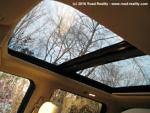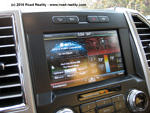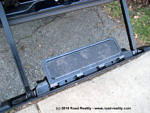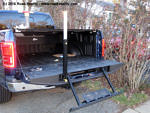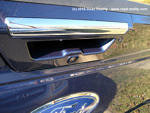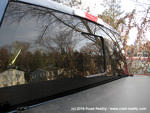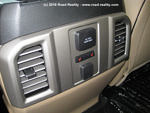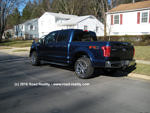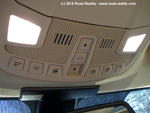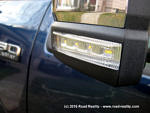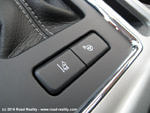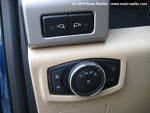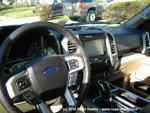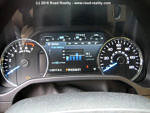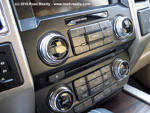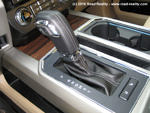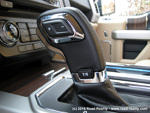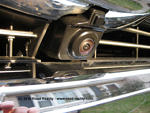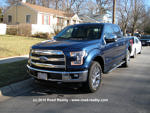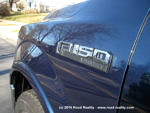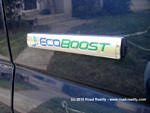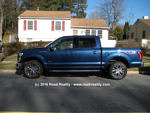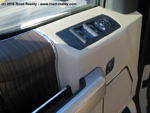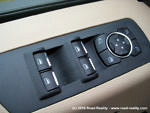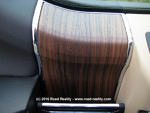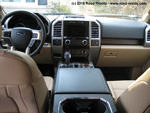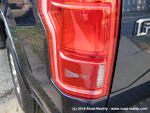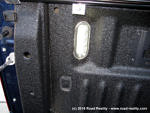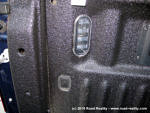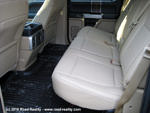 The all-new 2015 F-150. You’ve seen the commercials, heard all the hype, and now Road Reality is bringing you an extensive, hands-on review of the new aluminum-bodied truck from Ford. We’ll look at all the new features of the newly-redesigned truck, and explain some of the buzzwords. I’ll be taking the next few months to post individual articles on all the new technology Ford crammed into this truck so you can choose for yourself if it’s worth checking the option boxes. Read on for the review of my new 2015 Ford F-150 Lariat.
The all-new 2015 F-150. You’ve seen the commercials, heard all the hype, and now Road Reality is bringing you an extensive, hands-on review of the new aluminum-bodied truck from Ford. We’ll look at all the new features of the newly-redesigned truck, and explain some of the buzzwords. I’ll be taking the next few months to post individual articles on all the new technology Ford crammed into this truck so you can choose for yourself if it’s worth checking the option boxes. Read on for the review of my new 2015 Ford F-150 Lariat.
The American truck market is on fire. In the last decade, the Big Three (Ford, GM, RAM) have each tried to one-up the others with each model year, from optional features, to capacities, to fuel economy. Not a single year goes by between little changes, and complete makeovers have been quicker and more extensive, all in a bid to get hard-earned dollars from American truck buyers.
 To me, this competition is mostly driven by the changing demographic of truck buyers. The majority of buyers used to be blue-collar guys and gals who needed a truck to haul stuff and get work done. They wanted a regular cab, 8-foot bed truck with few frills. Once truck makers started adding extended cabs, DIY-ers and families started buying them, giving automakers an excuse to start adding more and more creature comforts and higher MSRPs, leading to the current glut of crew cab, short bed trucks with lots of tech, the “luxury truck” segment.
To me, this competition is mostly driven by the changing demographic of truck buyers. The majority of buyers used to be blue-collar guys and gals who needed a truck to haul stuff and get work done. They wanted a regular cab, 8-foot bed truck with few frills. Once truck makers started adding extended cabs, DIY-ers and families started buying them, giving automakers an excuse to start adding more and more creature comforts and higher MSRPs, leading to the current glut of crew cab, short bed trucks with lots of tech, the “luxury truck” segment.
My previous truck, a 2011 Ford F-150 Lariat, certainly fit that bill, what with its 8″ touch screen, heated and cooled front seats, moonroof, among other items that not long ago were reserved for the Mercedes S-Class crowd. The new truck takes that truck’s list of features, and darn-near doubles it.
 Then, for 2015, Ford turned the truck market on its head. It replaced the steel cab and bed of the F-150 with an aluminum version, on all trim levels. Cries of “beer can” trucks and higher insurance premiums came from competitors. Ford has marketed its new truck as being built of “military-grade” aluminum, which appears to be pure marketing speak. But, it works – at no point in automotive history has an automaker used so much aluminum in such a mass-produced vehicle. Sure, Jaguar and Audi have aluminum space-frame designs, but they make a fraction of the number of vehicles as Ford makes F-150s. Look beneath the aluminum, and you’ll find a beefed-up version of the previous generation’s steel frame.
Then, for 2015, Ford turned the truck market on its head. It replaced the steel cab and bed of the F-150 with an aluminum version, on all trim levels. Cries of “beer can” trucks and higher insurance premiums came from competitors. Ford has marketed its new truck as being built of “military-grade” aluminum, which appears to be pure marketing speak. But, it works – at no point in automotive history has an automaker used so much aluminum in such a mass-produced vehicle. Sure, Jaguar and Audi have aluminum space-frame designs, but they make a fraction of the number of vehicles as Ford makes F-150s. Look beneath the aluminum, and you’ll find a beefed-up version of the previous generation’s steel frame.
So, how is Ford’s gamble playing out? Great, as of the end of the 2015 model year. Sales numbers are in, and the Blue Oval is claiming another year of top truck sales, not to mention the F-150 is the best selling nameplate in America. In my experience with the new truck, they’ve hit a home run, and when I called my insurance company, I was pleasantly surprised to learn that my premiums wouldn’t be changing by replacing my 2011 Lariat with the 2015 version.
 There’s a myriad of options and trim levels one can opt for when building a new F-150. From the XL trim all the way to Platinum, regular cab / 8-foot bed to SuperCrew cab / 6.5-foot bed, there’s a truck for everyone. The tried-and-true truck guys can still get their work truck in XL or XLT trim, while the DIY-ers, construction foremen, and suburban cowboys can get a Lariat, King Ranch, or Platinum (while all three premium trims feature heated and cooled leather seats, the Platinum comes with massaging seats!).
There’s a myriad of options and trim levels one can opt for when building a new F-150. From the XL trim all the way to Platinum, regular cab / 8-foot bed to SuperCrew cab / 6.5-foot bed, there’s a truck for everyone. The tried-and-true truck guys can still get their work truck in XL or XLT trim, while the DIY-ers, construction foremen, and suburban cowboys can get a Lariat, King Ranch, or Platinum (while all three premium trims feature heated and cooled leather seats, the Platinum comes with massaging seats!).
 Along with trim level, you can get 2WD or 4WD, of course, with higher trim levels featuring a 4A (4-Auto) mode, which mimics All-Wheel-Drive (AWD). Then there are the engines. The base 3.5-liter V6 (282hp/253lbft) is one of 3 V6 options. (Remember the good ol’ days, when you had a V6 and a V8 option?) Up from the base engine is the new 2.7-liter V6 EcoBoost, good for 325hp/375lbft of torque. Next up is a 5.0-liter V8, which carries over from the previous generation (2011-2014) truck, and it’s good for 360hp/385lbft of torque. The big-power engine is another carryover, the 3.5-liter V6 EcoBoost, with which my new truck is equipped. It still has 365 horsepower and 420 foot-pounds of torque. It’s the big dog engine in the F-150 lineup, as the 6.2-liter V8 is no longer offered.
Along with trim level, you can get 2WD or 4WD, of course, with higher trim levels featuring a 4A (4-Auto) mode, which mimics All-Wheel-Drive (AWD). Then there are the engines. The base 3.5-liter V6 (282hp/253lbft) is one of 3 V6 options. (Remember the good ol’ days, when you had a V6 and a V8 option?) Up from the base engine is the new 2.7-liter V6 EcoBoost, good for 325hp/375lbft of torque. Next up is a 5.0-liter V8, which carries over from the previous generation (2011-2014) truck, and it’s good for 360hp/385lbft of torque. The big-power engine is another carryover, the 3.5-liter V6 EcoBoost, with which my new truck is equipped. It still has 365 horsepower and 420 foot-pounds of torque. It’s the big dog engine in the F-150 lineup, as the 6.2-liter V8 is no longer offered.
Cab and bed lengths are the same as they were before: lower trim levels come standard as a regular cab with an 8′ bed, with optional SuperCab (extended cab) and SuperCrew (crew cab) configurations with 5.5′, 6.5′ and 8′ beds. Higher trim levels start as SuperCabs with 6.5′ (Lariat) or SuperCrew cabs with 5.5′ beds (King Ranch, Platinum). The SuperCab still features front-opening “suicide” doors, whereas the competitors have gone to rear-opening, standard doors. This allows Ford to do without the B pillar, which separates the front and back seats in SuperCrew trucks, and allows easier loading of larger items.

Then, there are options. Lots of them. Manual windows and locks are still available, but good luck finding a truck equipped as such. Power everything is available – depending on the trim level, naturally – from windows and locks to pedals, mirrors, and the tilt/telescoping steering wheel. Seats range from cloth to the aforementioned massaging leather. The expected uprated radio is a 700w Sony system, with 10 speakers, including a subwoofer, which moves from underneath the passenger-side rear seat to a center mount behind the rear seat in the SuperCrew cab. Infotainment is SYNC2, with navigation-equipped trucks sporting an 8″ touchscreen featuring MyFordTouch (MFT) The standard single-panel moonroof is replaced on SuperCrew models with a twin-panel version, which takes up about 85% of the roof of the truck. The front section tilts and slides back, while the rear section is fixed in place. The upper trim levels replace the HID headlights of the 2012-2014 F-150 with LED units, and offer LED taillights as well. Mirror-mounted LED spotlights and bed-mounted LED lighting round out the lighting options.
 If you’re big on safety features and tech, the F-150 has you covered. Blind-spot monitoring (BLIS) with cross-traffic alert (CTA) is available, along with rear parking sensors, a backup camera, and on Tech Package trucks, a 360-degree camera system, which uses front grill, side mirror, and tailgate-mounted cameras to give a top-down view of the truck while making tight maneuvers. Class-exclusive Lane Keep Assist (LKA) and Adaptive Cruise Control (ACC) help to make highway driving easier. To help drivers set up and use these features, the steering wheel is festooned with buttons, and an 8″ productivity screen between the speedometer and tachometer offers setup for these features, as well as rain-sensing wipers and a multi-mode security system. There’s even a self-parking feature, which allows the truck to parallel park itself, even into extremely tight spots, without playing bumper cars. Of course, with all this tech, push-button start and keyless entry are on the option list as well. I’ll be posting individual reviews of these more complicated features in the near future.
If you’re big on safety features and tech, the F-150 has you covered. Blind-spot monitoring (BLIS) with cross-traffic alert (CTA) is available, along with rear parking sensors, a backup camera, and on Tech Package trucks, a 360-degree camera system, which uses front grill, side mirror, and tailgate-mounted cameras to give a top-down view of the truck while making tight maneuvers. Class-exclusive Lane Keep Assist (LKA) and Adaptive Cruise Control (ACC) help to make highway driving easier. To help drivers set up and use these features, the steering wheel is festooned with buttons, and an 8″ productivity screen between the speedometer and tachometer offers setup for these features, as well as rain-sensing wipers and a multi-mode security system. There’s even a self-parking feature, which allows the truck to parallel park itself, even into extremely tight spots, without playing bumper cars. Of course, with all this tech, push-button start and keyless entry are on the option list as well. I’ll be posting individual reviews of these more complicated features in the near future.
All this, and I haven’t even mentioned the redesign of the look and feel of the truck. At first glance, it resembles a cross between a GMC Sierra and the Toyota Tundra, but if you keep looking, you’ll notice that it keeps quite a few of the F-150’s typical design cues. Chiseled-but-smooth fender flares, hood lines, and cab sides, with round wheel wells, all point to previous Ford trucks. It’s a nicely cohesive design outside, which looks sharp and hopefully will age as well as the 2009-2014 body style did. The upright, big-rig inspired grill seems to have grown a bit, but isn’t out of place in today’s truck world. The tailgate is further sculpted, as was the last truck, most likely to improve fuel economy. In a departure from previous Ford trucks, the grill on the new truck does isn’t attached to the hood, which allowed Ford to install grill shutters on all F-150s, helping with engine warming and aerodynamics, all in a bid to improve fuel economy.
 Inside, Ford may have a few more hard plastics than competitors, but they’re done well. Soft-touch dash covers, arm rests and center console cover the surfaces you’ll touch the most, and the entire dash has been freshened. The leather on the Lariat’s steering wheel isn’t perfectly smooth, which some don’t like, but it makes for better control with less slipping for gloved hands. Small chrome touches on the Lariat and higher trims try to help justify the prices they command, along with wood-grain inserts on the door panels. The volume and climate controls knobs are certainly worlds better, with chrome knurling on the sides and glossy fronts, lending a true luxury feel. The center console is wider and deeper than before, offering storage for any number of items, which makes room for a cell phone slot between the console-mounted shifter and cup holders. If you need more seating, a column-mounted shifter with bench seats is still available. The interior is not quite Audi or Mercedes quality, but it’s got almost all of the same available tech. GM and RAM offer slightly nicer interiors, but their trucks don’t offer the luxury amenities found in the cabs of the F-150. GM does have 4G LTE in their trucks, which is important for some families. The squared-off interior design continues what is found on the outside, which appeals to me.
Inside, Ford may have a few more hard plastics than competitors, but they’re done well. Soft-touch dash covers, arm rests and center console cover the surfaces you’ll touch the most, and the entire dash has been freshened. The leather on the Lariat’s steering wheel isn’t perfectly smooth, which some don’t like, but it makes for better control with less slipping for gloved hands. Small chrome touches on the Lariat and higher trims try to help justify the prices they command, along with wood-grain inserts on the door panels. The volume and climate controls knobs are certainly worlds better, with chrome knurling on the sides and glossy fronts, lending a true luxury feel. The center console is wider and deeper than before, offering storage for any number of items, which makes room for a cell phone slot between the console-mounted shifter and cup holders. If you need more seating, a column-mounted shifter with bench seats is still available. The interior is not quite Audi or Mercedes quality, but it’s got almost all of the same available tech. GM and RAM offer slightly nicer interiors, but their trucks don’t offer the luxury amenities found in the cabs of the F-150. GM does have 4G LTE in their trucks, which is important for some families. The squared-off interior design continues what is found on the outside, which appeals to me.
 Which brings me to the review vehicle, which is a 502A-equipped SuperCrew Lariat, or Lariat Luxury in Ford speak. The 502A package includes a number of options, including BLIS, CTA, remote start, backup sensors, navigation, and the 700w Sony sound system. And then, whoever ordered it went wild checking option boxes. There’s a list at the bottom of this review, but suffice it to say, it’s more than well-equipped. The big-ticket items were the 3.5-liter V6 EcoBoost engine, twin-panel moonroof, Max Tow package, and the Tech Package, as well as the 20″ chrome wheels (ok, they’re PVD, Physical Vapor Deposition – think of it as powder coating that creates a chrome appearance, without the expensive and toxic chemicals). With the Medium Light Camel interior, the truck has a light, airy interior. We’ll see how the lighter leather holds up to wear and tear, but thankfully it’s not white, which typically stains easily and shows any dirt or anything that gets stuck in it. At the end of the day, the biggest differences between this truck and a loaded Platinum, are the lack of power running boards and massaging seats. If I could change anything, I would’ve gotten the SuperCrew cab with the 6.5′ bed, but the longer wheelbase truck simply won’t fit in my driveway or most parking places in my area. While the extra space in the cab is welcomed by all who have sat there, the longer bed would certainly help when I want to haul things.
Which brings me to the review vehicle, which is a 502A-equipped SuperCrew Lariat, or Lariat Luxury in Ford speak. The 502A package includes a number of options, including BLIS, CTA, remote start, backup sensors, navigation, and the 700w Sony sound system. And then, whoever ordered it went wild checking option boxes. There’s a list at the bottom of this review, but suffice it to say, it’s more than well-equipped. The big-ticket items were the 3.5-liter V6 EcoBoost engine, twin-panel moonroof, Max Tow package, and the Tech Package, as well as the 20″ chrome wheels (ok, they’re PVD, Physical Vapor Deposition – think of it as powder coating that creates a chrome appearance, without the expensive and toxic chemicals). With the Medium Light Camel interior, the truck has a light, airy interior. We’ll see how the lighter leather holds up to wear and tear, but thankfully it’s not white, which typically stains easily and shows any dirt or anything that gets stuck in it. At the end of the day, the biggest differences between this truck and a loaded Platinum, are the lack of power running boards and massaging seats. If I could change anything, I would’ve gotten the SuperCrew cab with the 6.5′ bed, but the longer wheelbase truck simply won’t fit in my driveway or most parking places in my area. While the extra space in the cab is welcomed by all who have sat there, the longer bed would certainly help when I want to haul things.
 The end result is a capable, powerful, versatile vehicle. With a weight loss of around 400lbs over my previous truck, even with the heavier SuperCrew cab (compared to the smaller SuperCab my 2011 truck had), the new truck is less cumbersome to drive. Acceleration, handling, and braking have all improved, which was to be expected, but it’s really night and day. I drove the 2011 F-150 back-to-back with the 2015, and the difference is greater than I thought it would be. The steering feel is better, which improves cornering. You won’t confuse it with a sports car, but between that and the smoother ride, you could almost forget you’re driving a 5,400lb truck. Even with 20″ wheels and the Max Tow package, this truck rides smoother than any truck I’ve driven before, including the RAM 1500 and GMC Sierra, both of which used to have a smoother ride than the F-150. Stopping distances seem shorter, with better pedal feel, for more confidence when braking. The Sport mode on the 6-speed automatic transmission changes the throttle tip-in and mapping, which can be used to burn thousands of miles off the rear tires in a heartbeat. If you really dip your big toe towards the firewall, the truck will spin its tires all the way through an intersection. It’s addictive, and brings plenty of smiles, especially when you realize that this vehicle weighs over two and a half tons.
The end result is a capable, powerful, versatile vehicle. With a weight loss of around 400lbs over my previous truck, even with the heavier SuperCrew cab (compared to the smaller SuperCab my 2011 truck had), the new truck is less cumbersome to drive. Acceleration, handling, and braking have all improved, which was to be expected, but it’s really night and day. I drove the 2011 F-150 back-to-back with the 2015, and the difference is greater than I thought it would be. The steering feel is better, which improves cornering. You won’t confuse it with a sports car, but between that and the smoother ride, you could almost forget you’re driving a 5,400lb truck. Even with 20″ wheels and the Max Tow package, this truck rides smoother than any truck I’ve driven before, including the RAM 1500 and GMC Sierra, both of which used to have a smoother ride than the F-150. Stopping distances seem shorter, with better pedal feel, for more confidence when braking. The Sport mode on the 6-speed automatic transmission changes the throttle tip-in and mapping, which can be used to burn thousands of miles off the rear tires in a heartbeat. If you really dip your big toe towards the firewall, the truck will spin its tires all the way through an intersection. It’s addictive, and brings plenty of smiles, especially when you realize that this vehicle weighs over two and a half tons.
Back to safety, the Technology and ACC packages include Collision Warning, activated when the truck is approaching another vehicle too fast. It triggers the heads-up red LED display on the windshield and also pre-charges the brakes, giving full braking power with little pedal pressure.
The Adaptive Cruise Control was one of the “killer apps” for me when I test drove the new truck, since I spend a fair amount of time on the highway. It’s another safety feature, and one I’ve come to love. The ACC system will pace the vehicle in front of you, up to your preset speed, using the brakes to slow the vehicle down to about 10 mph when necessary, and even downshifting to catch up when traffic speeds up again. The system is a huge stress reliever when it works, but it’s got a few bugs to work out – mainly driving by large trucks, heavy spray from said trucks, and a few shadows, mostly from large overhead signs, where the system momentarily brakes before speeding back up. Overall, it’s a well-tuned system, and I’m happy to have it.
Lane Keep Assist is another huge safety feature, which will actually steer the truck back into its lane when an unintentional drift is detected. When combined with Adaptive Cruise Control, the driver of a new F-150 can set his or her speed and not have to touch the pedals for many miles. LKA works, but after bouncing off of several lane markers, the truck will warn you to take a break and get a cup of coffee – don’t ask me how I know.
 Infotainment is big business in new vehicle development these days, and Ford gets praise or confusion from owners of its SYNC-equipped vehicles. The SYNC2 system, equipped in this truck with MyFord Touch, is a great improvement over the previous SYNC system offered from 2009 to 2012. It’s not quite as responsive as SYNC3, but the heated steering wheel is a soft button on the home screen, whereas it’s hidden in the Climate screen on SYNC3, so there are trade-offs. SYNC2 works well for everyday use, and even offers more natural-language commands, compared to the more menu-driven SYNC1 voice control system.
Infotainment is big business in new vehicle development these days, and Ford gets praise or confusion from owners of its SYNC-equipped vehicles. The SYNC2 system, equipped in this truck with MyFord Touch, is a great improvement over the previous SYNC system offered from 2009 to 2012. It’s not quite as responsive as SYNC3, but the heated steering wheel is a soft button on the home screen, whereas it’s hidden in the Climate screen on SYNC3, so there are trade-offs. SYNC2 works well for everyday use, and even offers more natural-language commands, compared to the more menu-driven SYNC1 voice control system.
Pro Tip: When test driving any new vehicle equipped with a touch screen, spend a few minutes with your salesperson in the dealership’s lot, testing out the different features before you start out in traffic. Trust me, it’ll make for a better test drive, and far less confusion and frustration than trying to drive and figure it out at the same time.
 Along with the Adaptive Cruise Control system, I was excited to try out the truck’s self-parking feature, which allows hands-off parallel parking. Pressing a button to the rear of the gear shifter, the system enters Park Assist mode, where it scans the sides of the truck for a suitable parking spot. Drivers can use the turn signal stalk to tell the truck which side to scan, and once it finds a spot, the truck gives an audible signal. At this point, you can shift the truck into reverse and let go of the steering wheel. While the drive modulates the gas and brake pedals, the truck does the steering to safely enter the parking spot, even if there’s barely a foot of space in front and back. Grabbing the steering wheel cancels the system. I found a tight spot and let the truck do its work, and it got the spot on the first try, better than I would’ve been comfortable doing in a $60,000 truck.
Along with the Adaptive Cruise Control system, I was excited to try out the truck’s self-parking feature, which allows hands-off parallel parking. Pressing a button to the rear of the gear shifter, the system enters Park Assist mode, where it scans the sides of the truck for a suitable parking spot. Drivers can use the turn signal stalk to tell the truck which side to scan, and once it finds a spot, the truck gives an audible signal. At this point, you can shift the truck into reverse and let go of the steering wheel. While the drive modulates the gas and brake pedals, the truck does the steering to safely enter the parking spot, even if there’s barely a foot of space in front and back. Grabbing the steering wheel cancels the system. I found a tight spot and let the truck do its work, and it got the spot on the first try, better than I would’ve been comfortable doing in a $60,000 truck.
 The other interior feature that deserves some attention is the 8″ productivity screen, nestled in the instrument binnacle. It contains a lot of information, specifically digital gauges for temperature, oil pressure, and fuel level. The digital fuel gauge now includes a distance-to-empty calculation, freeing up the rest of the screen for other uses. There are so many available displays now that Ford’s software people added a MyView display, which allows the driver to choose their favorite screens and order them for quick perusal. My favorites include fuel history, the two trip odometers, and navigation display, which shows the next turn, even if your passenger is playing with the radio on the infotainment screen. A welcome addition is a tire-by-tire pressure display, showing specific PSIs. This is a huge upgrade from the previous Ford system, which merely gave drivers a warning light letting them know that the truck thought a tire was low, but without telling them which one.
The other interior feature that deserves some attention is the 8″ productivity screen, nestled in the instrument binnacle. It contains a lot of information, specifically digital gauges for temperature, oil pressure, and fuel level. The digital fuel gauge now includes a distance-to-empty calculation, freeing up the rest of the screen for other uses. There are so many available displays now that Ford’s software people added a MyView display, which allows the driver to choose their favorite screens and order them for quick perusal. My favorites include fuel history, the two trip odometers, and navigation display, which shows the next turn, even if your passenger is playing with the radio on the infotainment screen. A welcome addition is a tire-by-tire pressure display, showing specific PSIs. This is a huge upgrade from the previous Ford system, which merely gave drivers a warning light letting them know that the truck thought a tire was low, but without telling them which one.

 Trucks are built to work, and the F-150 is no exception. With the lighter new cab and bed, payload and towing have both been increased. This loaded Lariat example has a 1,575lb payload capacity, including passengers and cargo. It’s also equipped with the Max Tow package, which gives it an upgraded rear bumper, front stabilizer bar, and a maximum towing capacity of 11,500lbs, when you’re using a weight-distributing hitch. That’s some serious capacity, even for one with all the tech features. It’ll be a shoe-in for those towing larger boats or travel trailers. There’s even an LED next to the backup camera on the tailgate, shedding light on whatever is behind the truck. It makes a big difference at night, and should greatly help hooking up a trailer. I haven’t had a chance to tow anything, but I did have over 800lbs of fresh-cut poplar logs in the bed, and other than smoothing out the ride a bit, the truck wasn’t complaining.
Trucks are built to work, and the F-150 is no exception. With the lighter new cab and bed, payload and towing have both been increased. This loaded Lariat example has a 1,575lb payload capacity, including passengers and cargo. It’s also equipped with the Max Tow package, which gives it an upgraded rear bumper, front stabilizer bar, and a maximum towing capacity of 11,500lbs, when you’re using a weight-distributing hitch. That’s some serious capacity, even for one with all the tech features. It’ll be a shoe-in for those towing larger boats or travel trailers. There’s even an LED next to the backup camera on the tailgate, shedding light on whatever is behind the truck. It makes a big difference at night, and should greatly help hooking up a trailer. I haven’t had a chance to tow anything, but I did have over 800lbs of fresh-cut poplar logs in the bed, and other than smoothing out the ride a bit, the truck wasn’t complaining.
 Helping get work done are the bed-mounted and mirror-mounted lights. The mirror-mounted lights are operated using buttons on the driver’s side of the dash, and provide a really bright, wide light for illuminating a job site. The bed-mounted lights help after dark, providing plenty of light, and come in quite handy when a bed cover is installed.
Helping get work done are the bed-mounted and mirror-mounted lights. The mirror-mounted lights are operated using buttons on the driver’s side of the dash, and provide a really bright, wide light for illuminating a job site. The bed-mounted lights help after dark, providing plenty of light, and come in quite handy when a bed cover is installed.

 Furthermore, the tailgate step, which I found quite helpful on my last truck, has been redesigned. The handle is now hidden behind the step in the tailgate, which allows for a fully flat tailgate, easier to load and unload sheets of plywood, sheetrock, etc.. The step is also spring-loaded, so no need to unfold it for use.
Furthermore, the tailgate step, which I found quite helpful on my last truck, has been redesigned. The handle is now hidden behind the step in the tailgate, which allows for a fully flat tailgate, easier to load and unload sheets of plywood, sheetrock, etc.. The step is also spring-loaded, so no need to unfold it for use.
If there’s a place I can give praise and ding the truck at the same time, it’s here. The tailgate on upper trim levels has extra wiring, both for locking and for opening. The lock and unlock buttons don’t just give access to the cab, but the bed as well. A separate button on the key fob will lower the damped tailgate as well, which came in handy when I had to load items in sub-freezing temperatures – I lowered the tailgate from inside, and then carried the items out and put them in the bed.
The drawback? In the case of a dead battery, the tailgate won’t open, so if you have a bed cover and your jump box or jumper cables are in the bed, you can’t get in. There’s a physical key inside of the key fob which can be used to enter the cab of the truck, however, so I recommend storing jump boxes or cables underneath the back seat, if possible.
The overall package presented by the F-150 is of a do-anything, go-anywhere vehicle, which strives to be an everyday vehicle, catering to the driver and making his or her driving experience easier. If you’re in the mood for cruising, set the ACC and let it do its job. If you’re alone on a two-lane back road, activate Sport mode and increase the fun level. When off road, the FX4 package’s skid plates will help protect the engine, transmission, and gas tank from dirt and rocks. It’s no rock crawler or Jeep Wrangler, but it’ll go anywhere most truck drivers want to go. I can attest to the truck’s snow performance, as it had no issues driving in up to 18″ of snow in four wheel drive, surely helped by the all-terrain 275/55/20 tires. The 4-Auto system works nicely as well, as I recently drove through wet, then snow pack-covered roads with zero issues. The Goodyear Wrangler Adventure w/Kevlar tires which came on this truck handled the adverse conditions with aplomb, and earlier in the winter, I ended up driving on ice and snow, with the only slippage occurring at traffic lights, and even then, only for a few feet, where the ice was thickest.
Summary:
Ford really knocked this one out of the park. Long-term reliability is still a huge question mark, as it is with any redesigned vehicle, but if initial indications are to be believed, the Blue Oval really has a winner on its hands. The fit, finish, materials, capabilities, available features, and MSRP are all increased over the 2009-2014 generation F-150. The last of which is the only worrisome one; where will the MSRPs stop? You can outfit a 2015 F-150 at almost $65,000 … which used to be reserved for heavy-duty trucks as well as full-on luxury cars.
The automaker has already taken a hit with the EPA, however, as comparably-equipped 2016 models have dropped 1 or 2 MPGs for city and highway, as compared to the 2015 truck. Specifically, 2016 Lariat trucks like mine are now rated at 16/22 MPG, which is closer in line with what I’m experiencing. Still an improvement over the 2011-2014 trucks, but not nearly as much of an improvement as what many have expected. Blame Ford for some gamesmanship with the EPA, as well as a need for cab/bed/engine/trim charts for trucks, where each can greatly affect fuel economy.
That said, Ford isn’t resting on its laurels, not even for a single model year. Recently announced additions are some new colors (Lithium, Shadow Black, etc.), and a new feature: Pro Trailer Backup Assist. A dash-mounted knob has been added to aid the driver in backing up a trailer. Further, a recent spy shot showed a diesel-powered test mule driving around, indicating that Ford may have a competitor to RAM’s EcoDiesel light-duty pickup.
I know I’ve said it before, but it’s an exciting time to be a truck guy in America. So many options to choose from, and all trucks just keep getting better and better. It’s come down to a preference of which badge and option package you like the most.
If you own a 2015+ Ford F-150 and would like to be featured in Road Reality’s Owner’s Log, drop us a line!
Competitors: Chevrolet Silverado 1500, GMC Sierra 1500, Nissan Titan, RAM 1500, Toyota Tundra
As-Tested:
Year: 2015
Make: Ford
Model: F-150 4×4 SuperCrew Cab Lariat EcoBoost (145″ Wheelbase – includes 5.5′ bed)
EPA Fuel Mileage: 17/23 City/Highway
Base Price: $45,090
Options:
$6,995: Equipment Group 502A (BLIS, Remote Start, Reverse Sensing System, LED Side-mirror Spotlights, 110v/400w Outlet, Sony Single CD w/HD Radio, Voice-activated Navigation)
$400: V6 EcoBoost Engine
$1,295: Twin Panel Moonroof
$1,250: Adaptive Cruise Control
$995: Max Trailer Tow Package (Integrated Trailer Brake Controller, Upgraded Rear Bumper, Upgraded Front Stabilizer Bar)
$770: FX4 Package (Skid Plates, Hill Descent Control)
$375: Tailgate Step
$995: 20″ Chrome-like PVD Wheels
$395: 36-Gallon Extended Range Fuel Tank
$440: Active Park Assist
$905: Technology Package (360-degree Camera, Heated Steering Wheel)
No-cost options:
275/55/20 OWL All-Terrain tires
3.55 Electronic Lock Rear Axle
7000# GVWR package
Lariat Chrome Appearance Package (6″ Angular Chrome Running Boards, Chrome Grille, Chrome Bumpers, Chrome Mirror Caps)
Medium Light Camel Interior
Total: $59,905
Destination: $1,195
Total Price Before Discounts: $61,100
Lariat Luxury Chrome/Sport Discount: $1,500
Technology Package/Park Assist/Adaptive Cruise Discount: $500
Total Discounts: $2,000
As-Tested Price: $59,100
Pre-purchase modifications: $699: Spray-in bed liner (done at the dealer). Total Price: $59,799.
Post-purchase modifications: $240.00: Husky X-act Contour Floor Liners, front and back; $899.99: BAK Revolver X2 tonneau cover; $249.99: BAK BAK Box 2
by John Suit

